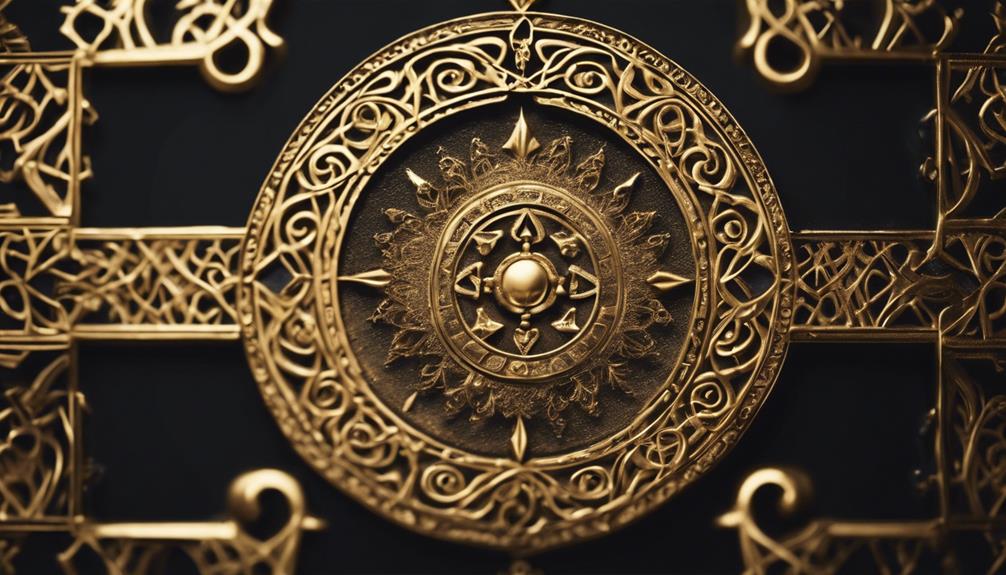Chrismon symbols reveal deep meanings in Christian faith. Stars symbolize divine guidance and hope, while triangles represent the Holy Trinity. Crosses signify Jesus' sacrifice and love, with doves embodying peace and divine presence. Lambs represent purity, and fish depict believers spreading His message. The Shepherds Crook signifies Jesus as the caring guide, and the Chi Rho (XP) represents His divine nature. Latin Cross, Descending Dove, and Crown of Thorns carry further significance. Exploring the rich symbolism of Chrismon ornaments provides profound insights into Christian beliefs and the Nativity story. Further investigation will unveil more about these symbolic representations.
Key Takeaways
- Stars and triangles symbolize divine guidance, hope, and the Holy Trinity.
- Crosses represent Jesus' sacrifice, love, and victory over sin.
- Lambs symbolize Jesus as the sacrificial Lamb of God and purity.
- Shepherds Crook signifies Jesus as the Good Shepherd offering guidance.
- Chi Rho (XP) symbolizes Jesus' divine nature as a monogram.
Symbolism of Stars and Triangles
Stars and triangles on Chrismon ornaments hold significant symbolism in Christian tradition, representing key aspects of the Nativity story and the Holy Trinity. The stars featured on Chrismon decorations aren't mere ornaments; they carry profound meaning, symbolizing the Nativity Star that guided the Magi to Jesus. This symbolizes divine guidance and the light of Christ illuminating our paths. In Christian faith, stars are also associated with the Star of Bethlehem, signifying the birth of Jesus and the hope He brings to the world.
Moreover, triangles on Chrismon ornaments represent the Holy Trinity, with each corner symbolizing the Father, Son, and Holy Spirit. This triangular shape serves as a visual reminder of the unity of the three persons of the Trinity, highlighting the core belief in the Christian faith of God's triune nature. The combination of stars and triangles on Chrismons conveys deep theological truths about the Christian beliefs, emphasizing the significance of the Nativity and the divine nature of the Holy Trinity.
Significance of Crosses and Doves
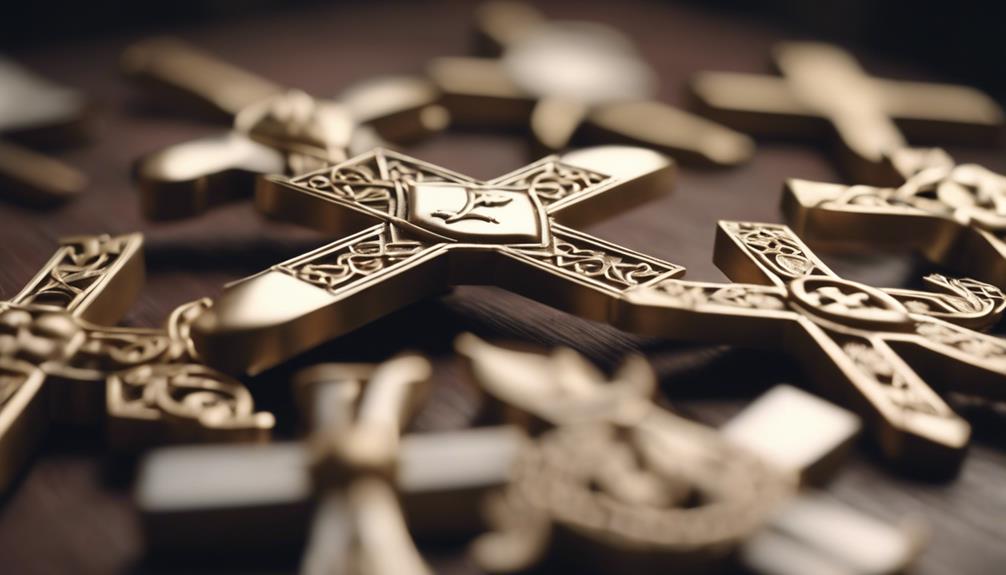
Why do crosses and doves hold significant symbolism in Christian tradition?
The Cross symbolizes Jesus' ultimate sacrifice for humanity, serving as a powerful reminder of his love and redemption. The Latin Cross, with its distinct horizontal and vertical beams, embodies faith, hope, and love. In contrast, the intricate design of the Celtic Cross symbolizes eternity, reflecting the interconnectedness of all things in God's plan. The Triumphant Cross signifies Jesus' triumph over sin and death, showcasing his victory over the world's darkness. Additionally, throughout history, crosses have been adapted into various artistic and cultural representations, each holding its own unique significance. For instance, death moth tattoo symbolism, often showcasing a skull and wings, can represent transformation and the cycle of life and death—paralleling the themes of sacrifice and resurrection seen in Christian teachings. These symbols intricately blend personal expression with deeper spiritual meanings, creating a bridge between the eternal and the temporal.
On the other hand, the Dove represents peace and the presence of the Holy Spirit. Often depicted descending from heaven, the Dove brings a sense of tranquility and divine guidance. Its gentle nature and symbolism of purity make it a fitting representation of the Holy Spirit's role in bringing comfort and wisdom to believers.
Together, the Cross and Dove stand as powerful symbols of faith, love, peace, and eternal hope in the Christian tradition.
Meaning Behind Lambs and Fish
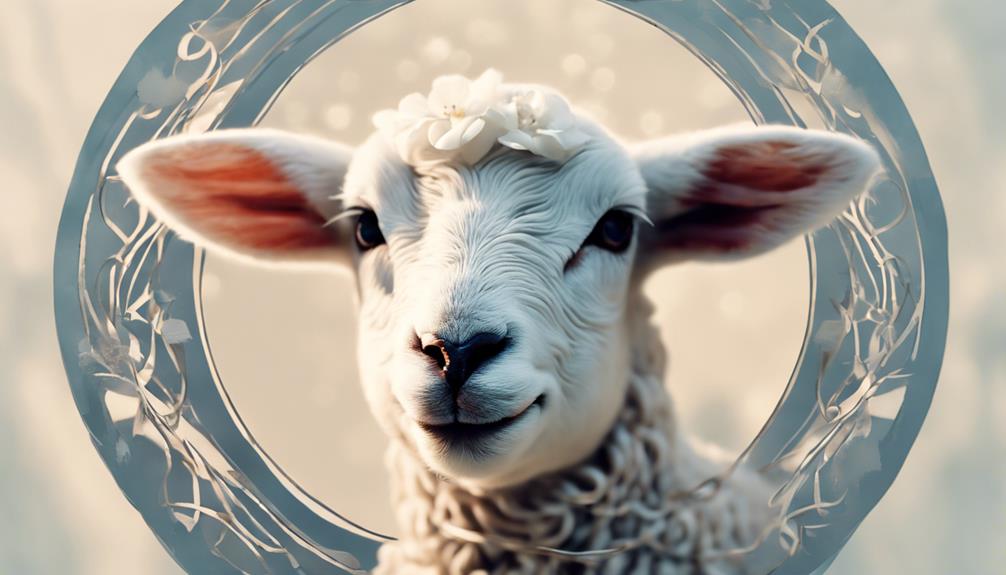
As we shift our focus to exploring the symbolism behind lambs and fish in Christian tradition, we uncover profound representations of Jesus Christ and believers' roles in spreading his message. Lambs, as Chrismon symbols, epitomize Jesus Christ as the sacrificial Lamb of God, embodying purity and the ultimate sacrifice for humanity's sins. The biblical significance of lambs traces back to sacrificial offerings in the Old Covenant, culminating in Jesus as the ultimate sacrificial Lamb.
On the other hand, fish symbols on Chrismons serve as identifiers for believers in Jesus Christ, symbolizing their mission as 'fishers of men,' casting the net of faith to bring others into the fold. This symbolism dates back to early Christianity, serving as a covert identifier during times of persecution. Both lambs and fish hold deep biblical meanings, reflecting the core tenets of Christian faith and the call for believers to emulate Christ's sacrificial love and spread his message of redemption.
Interpretation of Shepherds Crook
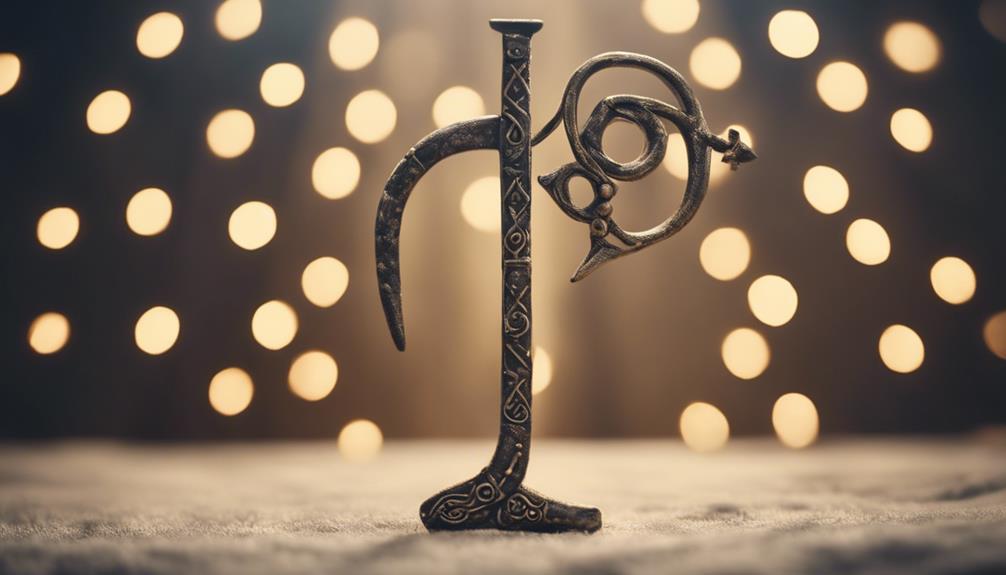
Guiding and protecting His flock, the Shepherds Crook on a Chrismon symbolizes Jesus as the Good Shepherd, embodying pastoral care and leadership. The intertwining of the Alpha and Omega symbols with the Shepherds Crook signifies Jesus as the ultimate shepherd, the beginning and the end, the first and the last.
This powerful symbol represents the nurturing and guidance that Jesus provides to His followers, akin to a shepherd watching over his sheep with unwavering care. The Shepherds Crook, adorned with the Alpha and Omega, on a Chrismon tree embodies the eternal presence and sovereignty of Jesus Christ in the lives of believers. It serves as a reminder of His constant protection and guidance, illustrating the profound connection between the shepherd and his flock.
The Shepherds Crook symbolizes not only the Good Shepherd but also the Alpha and Omega, encapsulating Jesus' role as the ultimate shepherd offering unwavering support and guidance to all who follow Him.
Understanding the Chi Rho (XP) Symbol
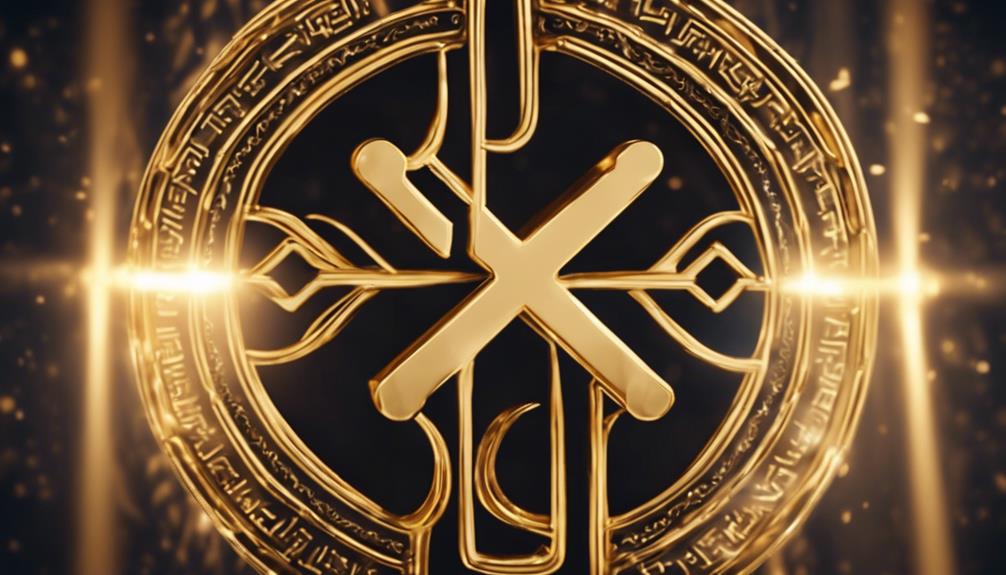
Exploring the significance of the Chi Rho (XP) Symbol reveals its profound connection to the identity and divinity of Jesus Christ in Christian theology. The Chi Rho, derived from the first two letters of 'Christ' in Greek, serves as a monogram symbolizing Jesus. Widely embraced by the early Christian church, this emblem signifies the central role of Christ in Christianity and His divine nature. Its usage as a representation of Christ's identity underscores the powerful impact and recognition it holds within the Christian faith.
The Chi Rho symbol not only encapsulates the essence of Jesus but also acts as a potent reminder of His significance in Christian theology. Through its simplicity and historical importance, the Chi Rho (XP) symbol stands as a distinctive marker of faith, resonating with believers worldwide. Its presence in Christian art, architecture, and symbolism further solidifies its status as a profound and enduring emblem of the Christian faith.
Exploring the Latin Cross
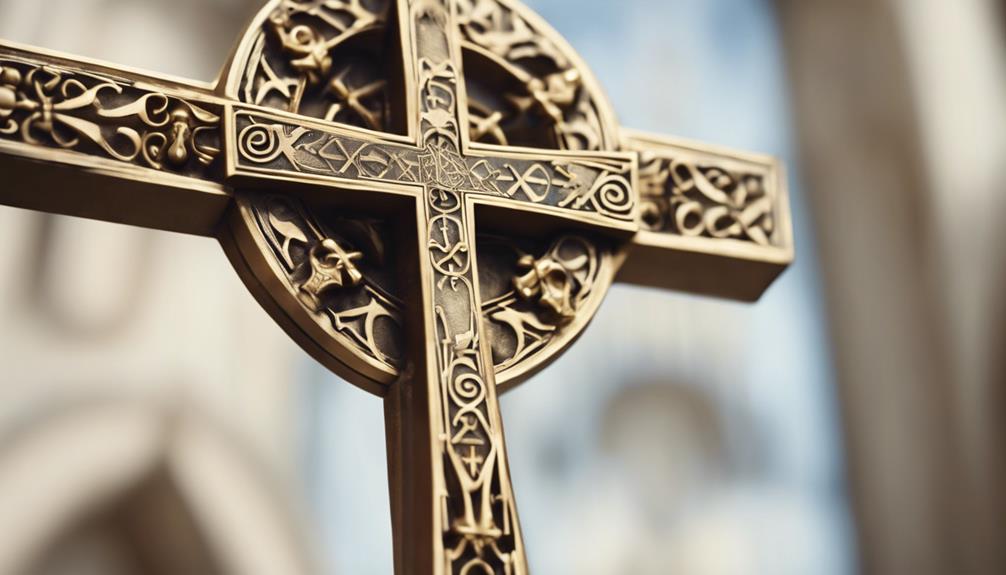
The Latin Cross holds deep significance in Christianity, symbolizing faith, hope, and love. It stands as a reminder of Jesus' ultimate sacrifice for humanity's redemption, embodying the core beliefs of the Christian faith.
Understanding the origins, representation, and historical importance of the Latin Cross provides valuable insights into its enduring significance.
Latin Cross Origins
With roots deeply embedded in Christian history, the Latin Cross symbolizes faith, hope, and love within the Christian community. Originating as a distinct form of the Christian cross, it signifies Jesus' sacrifice for humanity's sins.
This symbol is widely used in Christian art and religious iconography, often accompanied by the Greek letters Alpha and Omega to represent the beginning and the end. The Latin Cross holds significant meaning in Christian theology and serves as a reminder of the core beliefs of the faith.
Its simple yet powerful design has stood the test of time, resonating with believers around the world. The Latin Cross continues to be a prominent symbol of Christianity, embodying the central tenets of the religion.
Symbolic Representation
Symbolizing faith, hope, and love in Christian tradition, the Latin Cross embodies the profound significance of Jesus' sacrifice and teachings. The design of the Latin Cross, with its vertical and horizontal beams intersecting, is a powerful symbol of redemption and grace.
This symbol is widely used in church decorations, particularly during significant Christian celebrations like Christmas and Easter. The Latin Cross is a common Chrismon symbol, representing Jesus' sacrifice for all humanity. It serves as a reminder of the core beliefs of Christianity, emphasizing the importance of faith, hope, and love.
The Latin Cross holds great significance for many denominations, including Lutheran communities, and is often incorporated into Chrismon trees and other religious displays during the Christmas season.
Historical Significance
Entering a domain of historical exploration, our focus now shifts to the Latin Cross, delving into its significance throughout the ages.
The Latin Cross, one of the oldest Christian symbols, holds deep meaning. It represents the crucifixion of Jesus Christ and the core beliefs of Christianity. The design of the Latin Cross, with a longer vertical beam intersected by a shorter horizontal beam, symbolizes faith, hope, and love.
This symbol is widely recognized for depicting Jesus' sacrifice and redemption, with the five wounds of Jesus often associated with it. Throughout history, the Latin Cross has been one of the primary symbols used in Christianity, akin to the significance of the Christmas Tree in modern times.
Its historical significance underscores its enduring importance in Christian faith and tradition.
Implications of the Descending Dove

Descending dove, a symbol rich in meaning, embodies the essence of the Holy Spirit's presence and significance in Christian faith. Here are four key implications of the descending dove:
- Representation of Peace: The descending dove symbolizes peace, reflecting the calming and reassuring nature of the Holy Spirit within Christian teachings.
- Symbol of Purity: Linked to purity, the descending dove signifies the cleansing and purifying power of the Holy Spirit in the lives of believers.
- Sign of Divine Guidance: In Christian faith, the descending dove serves as a potent emblem of divine guidance, leading individuals towards righteousness and truth.
- Connection to Hope and New Beginnings: With ties to Noah's Ark, the descending dove also represents hope and the promise of new beginnings, reminding believers of God's faithfulness and grace.
The presence of the descending dove in Christian art and on Chrismon trees acts as a constant reminder of the Holy Spirit's role in bringing peace, purity, guidance, and hope to the faithful.
Symbolism of the Crown of Thorns
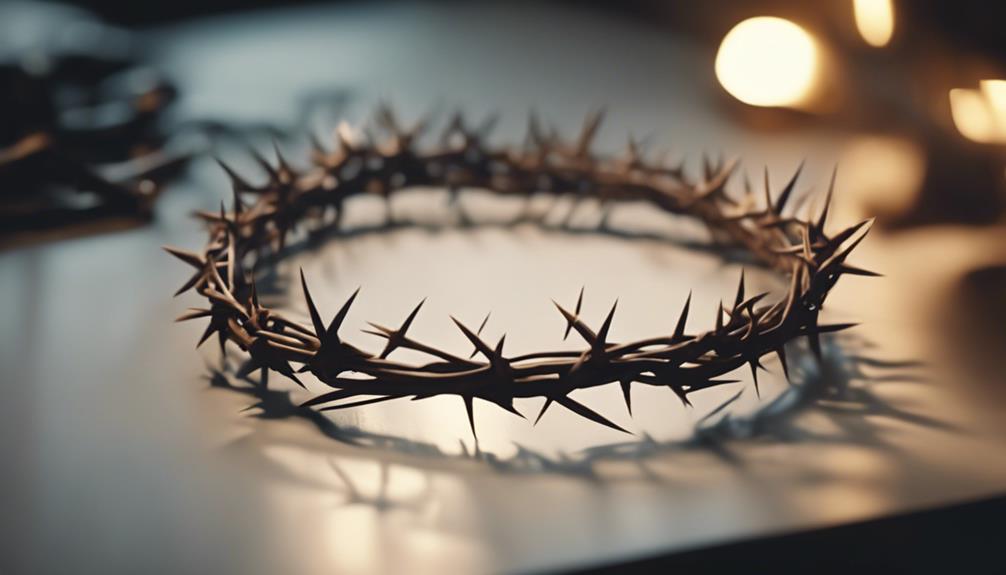
The Crown of Thorns, representing Jesus' excruciating sacrifice on the cross, stands as a poignant symbol of mankind's redemption and atonement. This Christian symbol embodies the immense pain and suffering that Jesus endured for the forgiveness of humanity's sins. The Crown of Thorns serves as a powerful reminder of the ultimate sacrifice made by Jesus out of love for all. It symbolizes the selfless act of atonement that paved the way for humanity's salvation. Visualizing the Crown of Thorns can evoke deep emotions and contemplation on the price paid for our redemption.
| Symbol | Meaning |
|---|---|
| Crown of Thorns | Represents Jesus' sacrifice and suffering on the cross. |
| Redemption | Symbolizes the forgiveness and salvation granted to humanity. |
| Atonement | Signifies the act of making amends for sins through Jesus' sacrifice. |
| Sacrifice | Reflects the selfless giving of Jesus for the benefit of mankind. |
| Christian Symbol | Serves as a reminder of the love and grace shown through Jesus' suffering. |
Frequently Asked Questions
What Does the Fish Mean in Chrismon?
When we ponder the fish symbol in Chrismon, it's important to remember its significance as a representation of Jesus Christ. In this particular setting, the fish symbolizes Jesus as the Son of God and Savior, reflecting His divine nature and mission on earth.
This ancient Christian symbol is a powerful reminder of faith and discipleship in Christianity, highlighting Jesus' role as the Messiah and provider of salvation.
What Does the Star Mean in Chrismon?
When we think about the Star in Chrismon, we see a powerful symbol of guidance, hope, and the divine presence of Jesus. It represents the Nativity Star that led the wise men to Jesus, symbolizing His birth and the light He brings to the world.
This celestial beacon not only signifies Christ as the Light of the world but also serves as a reminder of God's love and salvation, shining brightly with faith and grace.
What Does the Dove Mean on a Chrismon?
The dove on a Chrismon symbolizes peace and the Holy Spirit in Christian faith. It represents God's presence and peace in believers' lives, signifying spiritual purity and hope.
Often shown with an olive branch, symbolizing peace and reconciliation with God, the dove emphasizes faith in divine guidance and protection.
Its inclusion on a Chrismon tree underscores the importance of spiritual purity and the presence of the Holy Spirit in our lives.
What Is the History of the Chrismon Ornament?
We trace the history of the Chrismon ornament back to the influence of Mrs. Harry W. Spencer in 1957. These ornaments gained popularity through her efforts at Virginia's Lutheran Church of the Ascension.
Since then, Chrismon trees have become a common sight in churches during Advent and Christmas. Congregation members typically handcraft these ornaments, adding a personal touch to this cherished tradition.
Conclusion
To sum up, the meanings of Chrismon symbols are as diverse as they're intriguing. From stars to crosses, doves to lambs, each symbol carries its own significance and history.
As we explore further into the world of Chrismon symbols, we uncover a rich tapestry of spiritual meanings and connections. Each symbol carries profound significance, often reflecting deep historical and theological truths. For instance, the spiritual symbolism of yellow frequently represents gold, divinity, and eternal life, serving as a reminder of Christ’s glory and the light of God. These symbols, through their vibrant imagery, draw individuals into contemplation of their faith and the deeper mysteries of Christianity.
So next time you see these symbols, remember the depth of their symbolism and the stories they've to tell.

